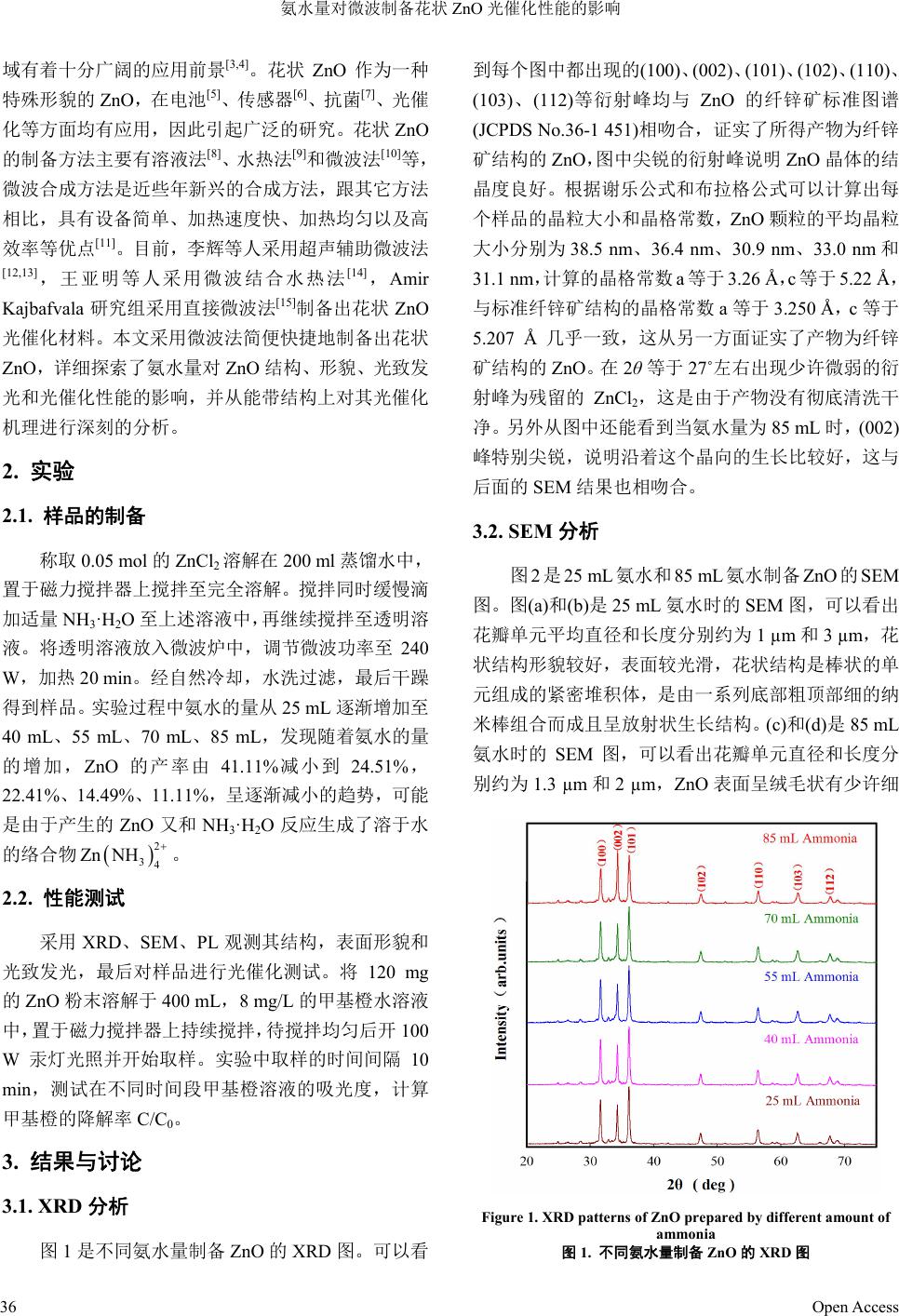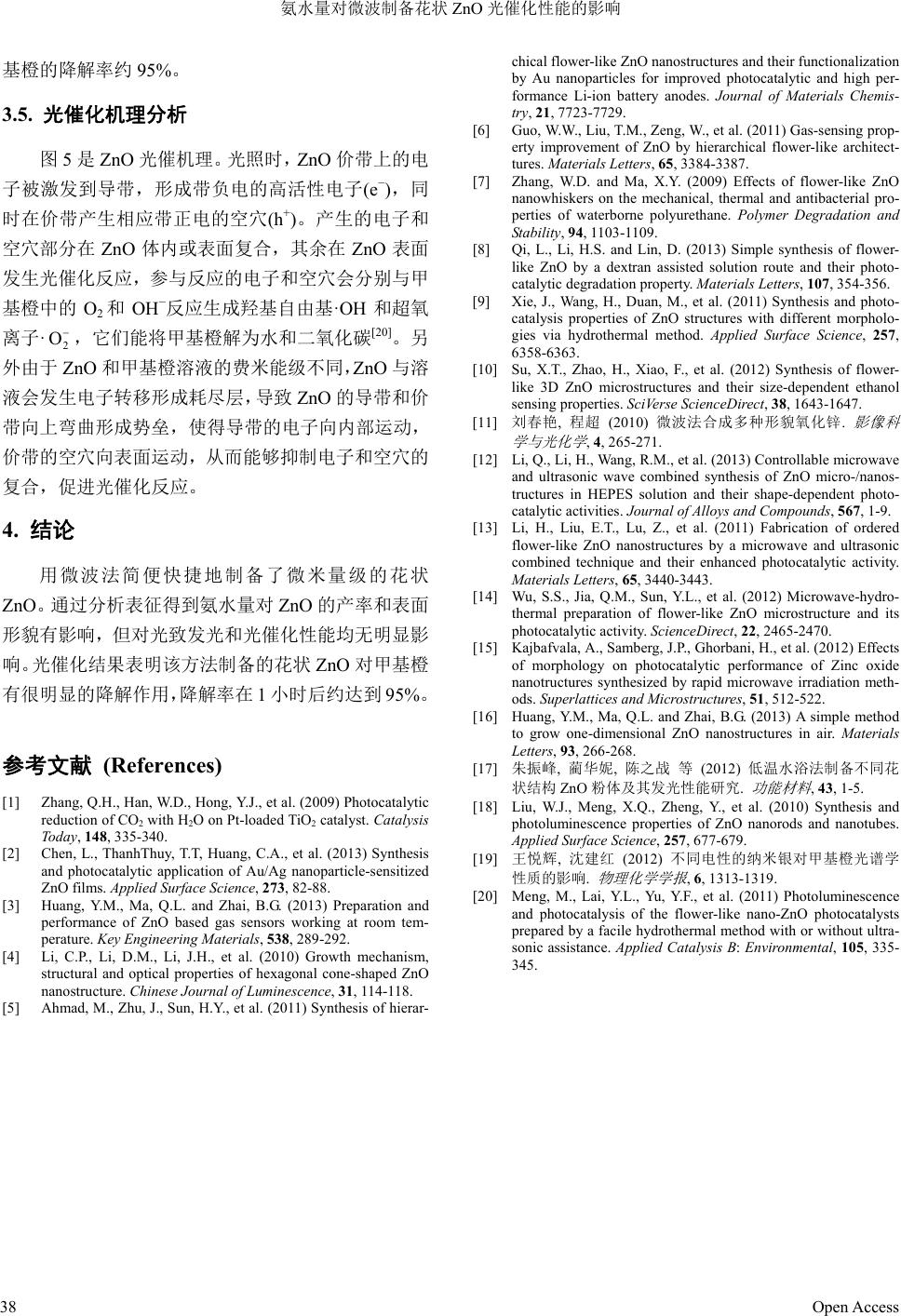 Optoelectronics 光电子, 2013, 3, 35-38 http://dx.doi.org/10.12677/oe.2013.34008 Published Online December 2013 (http://www.hanspub.org/journal/oe.html) Effect of Precursor Ammonia on Photocatalysis of Flower-Like ZnO Microstructures Prepared by Microwave Method Dong Liu, Qinglan Ma, Yuanming Huang* School of Mathematic and Physics, Changzhou University, Changzhou Email: *dongshanisland@126.com Received: Oct. 16th, 2013; revised: Oct. 18th, 2013; accepted: Oct. 22nd, 2013 Copyright © 2013 Dong Liu et al. This is an open access article distributed under the Creative Commons Attribution License, which permits unre- stricted use, distribution, and reproduction in any medium, provided the original work is properly cited. Abstract: Flower-like ZnO was prepared by using a simple and efficient microwave method in different amount of ammonia. The structure, morphology and optical properties of the products were characterized by XRD, SEM and PL. It was found that ZnO prepared by this method was micro dimension. Flower-like structure was consisted of a series of the thick bottom and thin top nanorods; photoluminescence showed a strong green emission peak. Photocatalytic meas- ure showed that ZnO had a strong function of degradation on methyl orange, and the degradation rate is about 95% after 1 hour. The amount of ammonia had effects on structure and morphology of ZnO, but had no significant effects on pho- toluminescence and photocatalysis. Keywords: Microwave Method; Flower-Like ZnO; Morphology; Photocatalysis 氨水量对微波制备花状 ZnO 光催化性能的影响 刘 冬,马青兰,黄远明* 常州大学数理学院,常州市 Email: *dongshanisland@126.com 收稿日期:2013 年10 月16 日;修回日期:2013年10 月18日;录用日期:2013年10月22日 摘 要:通过一种简便高效的微波法在不同氨水量下制备了花状 ZnO。采用 X射线衍射仪(XRD)、扫描电子显 微镜(SEM)及光致发光光谱仪(PL)对产物的结构、形貌以及光学特性进行表征。发现此种方法制备的 ZnO 为微 米量级,花状结构是由一系列底部粗、顶部细的纳米棒组合而成,光致发光显示有很强的绿光发光峰。光催化 测试表明ZnO 对甲基橙有较强的降解作用,1小时的降解率约95%。氨水量对ZnO的结构形貌有影响,对光致 发光和光催化效果无明显影响。 关键词:微波法;花状 ZnO;形貌;光催化 1. 引言 由于我国正在大力提倡绿色环保的理念,人们对 生活环境的质量要求也越来越高,环境污染已成为当 前一个日益严重的问题。光催化作为一种绿色、简便、 高效的新型环境处理方法,已得到了很多科研工作者 的重视,光催化氧化法能有效的破坏许多较难降解的 污染物,并最终氧化成二氧化碳和水等无机物,可减 少二次污染[1,2]。ZnO 作为一种重要的宽禁带半导体光 催化材料,具有无毒、价格优廉等优点,在光催化领 *通讯作者。 Open Access 35  氨水量对微波制备花状 ZnO 光催化性能的影响 域有着十分广阔的应用前景[3,4]。花状 ZnO 作为一种 特殊形貌的ZnO,在电池[5]、传感器[6]、抗菌[7]、光催 化等方面均有应用,因此引起广泛的研究。花状ZnO 的制备方法主要有溶液法[8]、水热法[9]和微波法[10]等, 微波合成方法是近些年新兴的合成方法,跟其它方法 相比,具有设备简单、加热速度快、加热均匀以及高 效率等优点[11]。目前,李辉等人采用超声辅助微波法 [12,13] ,王亚明等人采用微波结合水热法[14],Amir Kajbafvala 研究组采用直接微波法[15]制备出花状 ZnO 光催化材料。本文采用微波法简便快捷地制备出花状 ZnO,详细探索了氨水量对ZnO结构、形貌、光致发 光和光催化性能的影响,并从能带结构上对其光催化 机理进行深刻的分析。 2. 实验 2.1. 样品的制备 称取 0.05 mol 的ZnCl2溶解在200 ml 蒸馏水中, 置于磁力搅拌器上搅拌至完全溶解。搅拌同时缓慢滴 加适量 NH3·H2O至上述溶液中,再继续搅拌至透明溶 液。将透明溶液放入微波炉中,调节微波功率至 240 W,加热 20 min。经自然冷却,水洗过滤,最后干躁 得到样品。实验过程中氨水的量从 25 mL 逐渐增加至 40 mL、55 mL、70 mL、85 mL,发现随着氨水的量 的增加,ZnO 的产率由 41.11%减小到 24.51%, 22.41%、14.49%、11.11%,呈逐渐减小的趋势,可能 是由于产生的 ZnO 又和NH3·H2O反应生成了溶于水 的络合物 。 2 34 Zn NH 2.2. 性能测试 采用 XRD、SEM、PL 观测其结构,表面形貌和 光致发光,最后对样品进行光催化测试。将 120 mg 的ZnO 粉末溶解于400 mL,8 mg/L 的甲基橙水溶液 中,置于磁力搅拌器上持续搅拌,待搅拌均匀后开 100 W汞灯光照并开始取样。实验中取样的时间间隔 10 min,测试在不同时间段甲基橙溶液的吸光度,计算 甲基橙的降解率C/C0。 3. 结果与讨论 3.1. XRD分析 图1是不同氨水量制备 ZnO的XRD 图。可以看 到每个图中都出现的(100)、(002)、(10 1)、(1 02)、(110 )、 (103)、(112)等衍射峰均与 ZnO 的纤锌矿标准图谱 (JCPDS No.36-1 451)相吻合,证实了所得产物为纤锌 矿结构的ZnO,图中尖锐的衍射峰说明ZnO 晶体的结 晶度良好。根据谢乐公式和布拉格公式可以计算出每 个样品的晶粒大小和晶格常数, ZnO 颗粒的平均晶粒 大小分别为 38.5 nm、36.4 nm、30.9 nm、33.0 nm和 31.1 nm,计算的晶格常数 a等于 3.26 Å,c等于 5.22 Å, 与标准纤锌矿结构的晶格常数a等于3.250 Å,c等于 5.207 Å几乎一致,这从另一方面证实了产物为纤锌 矿结构的ZnO。在 2θ等于 27˚左右出现少许微弱的衍 射峰为残留的 ZnCl2,这是由于产物没有彻底清洗干 净。另外从图中还能看到当氨水量为85 mL 时,(002) 峰特别尖锐,说明沿着这个晶向的生长比较好,这与 后面的 SEM 结果也相吻合。 3.2. SEM分析 图2是25 mL氨水和 85 mL氨水制备 ZnO 的SEM 图。图(a)和(b)是25 mL 氨水时的 SEM 图,可以看出 花瓣单元平均直径和长度分别约为1 µm 和3 µm,花 状结构形貌较好,表面较光滑,花状结构是棒状的单 元组成的紧密堆积体,是由一系列底部粗顶部细的纳 米棒组合而成且呈放射状生长结构。 (c)和(d)是85 mL 氨水时的 SEM 图,可以看出花瓣单元直径和长度分 别约为 1.3 µm和2 µm,ZnO 表面呈绒毛状有少许细 Figure 1. XRD patterns of ZnO prepared by different amount of ammonia 图1. 不同氨水量制备 ZnO 的XRD 图 Open Access 36  氨水量对微波制备花状 ZnO 光催化性能的影响 Figur e 2. SEM im ages of ZnO prepar ed by 25 mL and 85 mL am monia 图2. 25 mL氨水和 85 mL氨水制备 ZnO 的SEM图 微的孔洞,纳米棒生长方向较单一,花瓣发生团聚导 致形貌不规则。可见随着氨水量的增加,产物表面变 得粗糙,花瓣发生团聚。因为ZnO是一种极性晶体, 不同晶面有不同的生长速率[16],正极性(001)面更容易 沉积生长单元 ,从而产生的 ZnO 沿着C轴 生长形成 ZnO 纳米棒,ZnO 沿各个方向生长,最终 ZnO 纳米棒在核上定向排列结果形成从中心向外发 散的花状结构[17]。 2 4 Zn OH 3.3. PL分析 图3是不同氨水量制备 ZnO的PL 光谱。从图中 能观察到不同氨水量制备ZnO 的发光峰均位于 538 nm 左右,除了强度略有不同之外无明显差异,说明 氨水量对 ZnO 的PL 性能影响很小。图中 538 nm处 的绿光发光峰,通常认为是与氧空位缺陷有关的发光 [18],另外该发光峰较强,说明产物中的氧缺陷比例较 大,从而导致ZnO 在370 nm处的本征发光峰几乎没 有。 3.4. 光催化测试分析 图4是ZnO 的光催化测试结果。图(a)是25 mL 氨水时甲基橙溶液的吸光度,可以看出甲基橙有两个 吸收峰,位于 270 nm 和464 nm左右,分别是苯环结 构的吸收峰和偶氮键的吸收峰[19],两个吸收峰均随着 时间逐渐降低,到60 min 吸收峰几乎是一条直线,说 明甲基橙分子完全被降解。图(b) 是甲基橙的降解率 图,可以看到每个样品随着时间的降解效果是近似 的,说明氨水量对光催化效果影响很小,从图中还能 看出花状ZnO 对甲基橙的降解作用很强,1小时后甲 Figure 3. PL spectra of ZnO prepared by different amount of am- monia 图3. 不同氨水量制备 ZnO 的PL光谱 Figure 4. (a) Photocatalytic degradation of methyl orange of ZnO prepared by 25 mL ammonia; (b) Photocatalytic efficiency of ZnO prepared by different amount of ammonia 图4. (a) 25 mL氨水制备 ZnO 催化甲基橙的降解;(b) 不同氨水量 制备 ZnO 的光催化效率 · O2 - O2 · O2 - O2 · O2 - O2 VB CB - + -- --- - - - - ++ + + - + hν · OH OH - VB CB - + -- --- - - - - ++ + - hν · OH OH - · OH OH - + + Figure 5. Photocatalytic mechanism of ZnO 图5. ZnO光催化机理 Open Access 37  氨水量对微波制备花状 ZnO 光催化性能的影响 Open Access 38 基橙的降解率约95%。 3.5. 光催化机理分析 图5是ZnO 光催机理。光照时,ZnO 价带上的电 子被激发到导带,形成带负电的高活性电子(e−),同 时在价带产生相应带正电的空穴(h+)。产生的电子和 空穴部分在 ZnO 体内或表面复合,其余在 ZnO 表面 发生光催化反应,参与反应的电子和空穴会分别与甲 基橙中的 O2和OH−反应生成羟基自由基·OH和超氧 离子·,它们能将甲基橙解为水和二氧化碳[20]。另 外由于 ZnO 和甲基橙溶液的费米能级不同,ZnO 与溶 液会发生电子转移形成耗尽层,导致ZnO的导带和价 带向上弯曲形成势垒,使得导带的电子向内部运动, 价带的空穴向表面运动,从而能够抑制电子和空穴的 复合,促进光催化反应。 2 O 4. 结论 用微波法简便快捷地制备了微米量级的花状 ZnO。通过分析表征得到氨水量对ZnO 的产率和表面 形貌有影响,但对光致发光和光催化性能均无明显影 响。光催化结果表明该方法制备的花状ZnO 对甲基橙 有很明显的降解作用,降解率在 1小时后约达到95%。 参考文献 (References) [1] Zhang, Q.H., Han, W.D., Hong, Y.J., et al. (2009) Photocatalytic reduction of CO2 with H2O on Pt-loaded TiO2 catalyst. Catalysis Today, 148, 335-340. [2] Chen, L., ThanhThuy, T.T, Huang, C.A., et al. (2013) Synthesis and photocatalytic application of Au/Ag nanoparticle-sensitized ZnO films. Applied Surface Science, 273, 82-88. [3] Huang, Y.M., Ma, Q.L. and Zhai, B.G. (2013) Preparation and performance of ZnO based gas sensors working at room tem- perature. Key Engineering Materials, 538, 289-292. [4] Li, C.P., Li, D.M., Li, J.H., et al. (2010) Growth mechanism, structural and optical properties of hexagonal cone-shaped ZnO nanostructure. Chinese Journal of Luminescence, 31, 114-118. [5] Ahmad, M., Zhu, J., Sun, H.Y., et al. (2011) Synthesis of hierar- chical flower-like ZnO nanostructures and their functionalization by Au nanoparticles for improved photocatalytic and high per- formance Li-ion battery anodes. Journal of Materials Chemis- try, 21, 7723-7729. [6] Guo, W.W., Liu, T.M., Zeng, W., et al. (2011) Gas-sensing prop- erty improvement of ZnO by hierarchical flower-like architect- tures. Materials Letters, 65, 3384-3387. [7] Zhang, W.D. and Ma, X.Y. (2009) Effects of flower-like ZnO nanowhiskers on the mechanical, thermal and antibacterial pro- perties of waterborne polyurethane. Polymer Degradation and Stability, 94, 1103-1109. [8] Qi, L., Li, H.S. and Lin, D. (2013) Simple synthesis of flower- like ZnO by a dextran assisted solution route and their photo- catalytic degradation property. Materials Letters, 107, 354-356. [9] Xie, J., Wang, H., Duan, M., et al. (2011) Synthesis and photo- catalysis properties of ZnO structures with different morpholo- gies via hydrothermal method. Applied Surface Science, 257, 6358-6363. [10] Su, X.T., Zhao, H., Xiao, F., et al. (2012) Synthesis of flower- like 3D ZnO microstructures and their size-dependent ethanol sensing properties. SciVerse ScienceDirect, 38, 1643-1647. [11] 刘春艳, 程超 (2010) 微波法合成多种形貌氧化锌. 影像科 学与光化学 , 4, 265-271. [12] Li, Q., Li, H., Wang, R.M., et al. (2013) Controllable microwave and ultrasonic wave combined synthesis of ZnO micro-/nanos- tructures in HEPES solution and their shape-dependent photo- catalytic activities. Journal of Alloys and Compounds, 567, 1-9. [13] Li, H., Liu, E.T., Lu, Z., et al. (2011) Fabrication of ordered flower-like ZnO nanostructures by a microwave and ultrasonic combined technique and their enhanced photocatalytic activity. Materials Letters, 65, 3440-3443. [14] Wu, S.S., Jia, Q.M., Sun, Y.L., et al. (2012) Microwave-hydro- thermal preparation of flower-like ZnO microstructure and its photocatalytic activity. ScienceDirect, 22, 2465-2470. [15] Kajbafvala, A., Samberg, J.P., Ghorbani, H., et al. (2012) Effects of morphology on photocatalytic performance of Zinc oxide nanotructures synthesized by rapid microwave irradiation meth- ods. Superlattices and Microstructures, 51, 512-522. [16] Huang, Y.M., Ma, Q.L. and Zhai, B.G. (2013) A simple method to grow one-dimensional ZnO nanostructures in air. Materials Letters, 93, 266-268. [17] 朱振峰, 蔺华妮, 陈之战 等 (2012) 低温水浴法制备不同花 状结构 ZnO 粉体及其发光性能研究. 功能材料 , 43, 1-5. [18] Liu, W.J., Meng, X.Q., Zheng, Y., et al. (2010) Synthesis and photoluminescence properties of ZnO nanorods and nanotubes. Applied Surface Science, 257, 677-679. [19] 王悦辉, 沈建红 (2012) 不同电性的纳米银对甲基橙光谱学 性质的影响. 物理化学学报 , 6, 1313-1319. [20] Meng, M., Lai, Y.L., Yu, Y.F., et al. (2011) Photoluminescence and photocatalysis of the flower-like nano-ZnO photocatalysts prepared by a facile hydrothermal method with or without ultra- sonic assistance. Applied Catalysis B: Environmental, 105, 335- 345. |